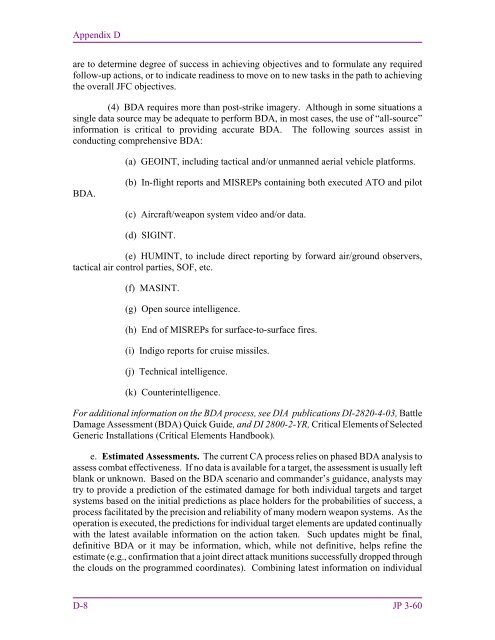Joint Targeting
1F87id9
1F87id9
Create successful ePaper yourself
Turn your PDF publications into a flip-book with our unique Google optimized e-Paper software.
Appendix D<br />
are to determine degree of success in achieving objectives and to formulate any required<br />
follow-up actions, or to indicate readiness to move on to new tasks in the path to achieving<br />
the overall JFC objectives.<br />
(4) BDA requires more than post-strike imagery. Although in some situations a<br />
single data source may be adequate to perform BDA, in most cases, the use of “all-source”<br />
information is critical to providing accurate BDA. The following sources assist in<br />
conducting comprehensive BDA:<br />
(a) GEOINT, including tactical and/or unmanned aerial vehicle platforms.<br />
BDA.<br />
(b) In-flight reports and MISREPs containing both executed ATO and pilot<br />
(c) Aircraft/weapon system video and/or data.<br />
(d) SIGINT.<br />
(e) HUMINT, to include direct reporting by forward air/ground observers,<br />
tactical air control parties, SOF, etc.<br />
(f) MASINT.<br />
(g) Open source intelligence.<br />
(h) End of MISREPs for surface-to-surface fires.<br />
(i) Indigo reports for cruise missiles.<br />
(j) Technical intelligence.<br />
(k) Counterintelligence.<br />
For additional information on the BDA process, see DIA publications DI-2820-4-03, Battle<br />
Damage Assessment (BDA) Quick Guide, and DI 2800-2-YR, Critical Elements of Selected<br />
Generic Installations (Critical Elements Handbook).<br />
e. Estimated Assessments. The current CA process relies on phased BDA analysis to<br />
assess combat effectiveness. If no data is available for a target, the assessment is usually left<br />
blank or unknown. Based on the BDA scenario and commander’s guidance, analysts may<br />
try to provide a prediction of the estimated damage for both individual targets and target<br />
systems based on the initial predictions as place holders for the probabilities of success, a<br />
process facilitated by the precision and reliability of many modern weapon systems. As the<br />
operation is executed, the predictions for individual target elements are updated continually<br />
with the latest available information on the action taken. Such updates might be final,<br />
definitive BDA or it may be information, which, while not definitive, helps refine the<br />
estimate (e.g., confirmation that a joint direct attack munitions successfully dropped through<br />
the clouds on the programmed coordinates). Combining latest information on individual<br />
D-8 JP 3-60


